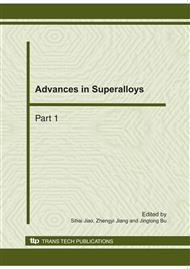p.987
p.991
p.996
p.1000
p.1004
p.1009
p.1013
p.1017
p.1022
Effect of Nd Content on the Microstructures and Mechanical Properties of As-Cast Mg15Al-xNd Alloys
Abstract:
Mg15Al-xNd (x=0, 0.5, 1.0, 1.5, 2.0and 4.0wt.%) alloys were prepared by metal mould casting method and the microstructures and mechanical properties were investigated. The results demonstrate that primary α-Mg grain is significantly refined with the addition of Nd element in Mg15Al alloy, and the best refinement is reached at 1.0wt.%Nd content. Further increasing Nd content leads to the coarsening of primary α-Mg grains. The added Nd element is also the reason of the refined eutectic β-Mg17Al12 and increased dispersion. The β-Mg17Al12 phase is thoroughly changed from fibrous coupled eutectic into divorced eutectic when Nd content reaches 1.5wt.%. Al11Nd3 phase is formed when the addition of Nd reaches to 1.0wt.% and Al2Nd phase emerges in the microstructure with increasing Nd content up to 4.0wt%. Addition of Nd element significantly improves the mechanical properties of Mg15Al alloy at room temperature. The best tensile strength and elongation is achieved by adding 1.0wt% Nd into Mg15Al alloy.
Info:
Periodical:
Pages:
1004-1008
Citation:
Online since:
October 2010
Authors:
Keywords:
Price:
Сopyright:
© 2011 Trans Tech Publications Ltd. All Rights Reserved
Share:
Citation:


